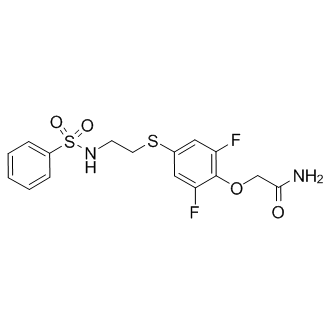| Cas No.: | 141286-78-4 |
| Chemical Name: | 2-[2,6-Difluoro-4-[[2-[(phenylsulfonyl)amino]ethyl]thio]phenoxy]acetamide |
| SMILES: | FC1=CC(SCCNS(C2=CC=CC=C2)(=O)=O)=CC(F)=C1OCC(N)=O |
| Formula: | C16H16F2N2O4S2 |
| M.Wt: | 402.44 |
| Sotrage: | 2 years -20°C Powder, 2 weeks 4°C in DMSO, 6 months -80°C in DMSO |
| Description: | PEPA is an allosteric modulator of AMPA receptors; binds to the GluA2o and GluA3o LBDs and can be utilized as an indicator of AMPA receptor heterogeneity. |
| In Vivo: | PEPA (3, 10, 30mg/kg body weight) or vehicle was intraperitoneally administered into stressed mice once before the first extinction session. The significant decrease of the freezing response in the extinction sessions was only seen in the 30mg/kg PEPA-administered stressed mice, compared with vehicle-administered stressed mice [3]. |
| In Vitro: | PEPA dose-dependently potentiated AMPA-induced increase of [Ca2+]i. In 90% (72 out of 80) of the cells in which cyclothiazide acts, PEPA potentiated the increased [Ca2+]i induced by AMPA with pronounced cell-to-cell variation in rat hippocampal cultures [1]. PEPA bound to the binding domains of the GluA2 and GluA3 flop isoforms of AMPA receptors [2]. coapplication of AMPA with PEPA protected hippocampal CA1 neurons from brain ischemia-induced death. Coapplication of AMPA with PEPA could prevent downregulated expression of GluR2 subunit caused by ischemia and increase BDNF expression via Lyn-ERK1/2-CREB signaling [4]. |

 DC Chemicals' products qualify for U.S. tariff exemptions. We guarantee no price increases due to customs duties and maintain stable supply, continuing to deliver reliable research solutions to our American clients.
DC Chemicals' products qualify for U.S. tariff exemptions. We guarantee no price increases due to customs duties and maintain stable supply, continuing to deliver reliable research solutions to our American clients.





















